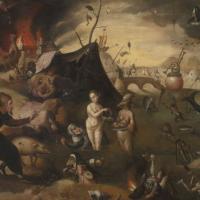Hieronymus Bosch
Temptation Of St. Anthony
$540.00
Hieronymus Bosch
Hieronymus Bosch ( 1450-1516 )
Hieronymus Bosch (born Jheronimus van Aken 1450 – 9 August 1516) was a Dutch/Netherlandish draughtsman and painter from Brabant. He is one of the most notable representatives of the Early Netherlandish painting school. His work contains fantastic illustrations of religious concepts and narratives. Within his lifetime his work was collected in the Netherlands, Austria, and Spain, and widely copied, especially his macabre and nightmarish depictions of hell.
Little is known of Bosch's life, though there are some records. He spent most of it in the town of 's-Hertogenbosch, where he was born in his grandfather's house. The roots of his forefathers are in Nijmegen and Aachen (which is visible in his surname: Van Aken). His pessimistic and fantastical style cast a wide influence on northern art of the 16th century, with Pieter Bruegel the Elderbeing his best-known follower. Today he is seen as a hugely individualistic painter with deep insight into humanity's desires and deepest fears. Attribution has been especially difficult; today only about twenty-five paintings are confidently given to his hand along with eight drawings. Approximately another half dozen paintings are confidently attributed to his workshop. His most acclaimed works consist of a few triptych altarpieces, including The Garden of Earthly Delights.
The exact number of Bosch's surviving works has been a subject of considerable debate. His signature can be seen on only seven of his surviving paintings, and there is uncertainty whether all the paintings once ascribed to him were actually from his hand. It is known that from the early 16th century onwards numerous copies and variations of his paintings began to circulate. In addition, his style was highly influential, and was widely imitated by his numerous followers.
Over the years, scholars have attributed to him fewer and fewer of the works once thought to be his. This is partly a result of technological advances such as infrared reflectography, which enable researchers to examine a painting's underdrawing. Art historians of the early and mid-20th century, such as Tolnay and Baldass, identified between thirty and fifty paintings that they believed to be by Bosch's hand, while a later monograph by Gerd.



